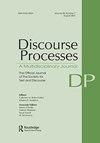来自依恋结构的眼动追踪证据支持话语-句子互动的序列模型
IF 2.1
2区 心理学
Q2 PSYCHOLOGY, EDUCATIONAL
引用次数: 0
摘要
许多心理语言学研究考察人们如何孤立地分析句子;然而,多年来在语篇处理方面的研究表明,句子级解释在某些阶段会受到语篇级信息的影响。关于这种自上而下的相互作用的时间动态,过去20年的证据仍然是混杂的。特别是,读者在解析之前和过程中使用话语模型对某些语法结构产生期望的动态描述,不同于在将句子材料整合到话语模型之前采用算法先过处理机制的连续描述。为了检验这两种理论之间的差异,本研究调查了在阅读暂时模糊的依恋结构时的眼动行为,这些结构在依恋解决方面有匹配、不匹配或中立的偏见。没有证据表明读者系统地使用语篇信息来产生结构性期望,这与在句子-语篇界面处理的一系列报道相一致。扫描路径分析进一步强调,当参与者遇到不符合先前语境的话语延续时,重读的确认性。披露声明作者未报告潜在的利益冲突。数据可用性声明所有材料、数据和分析都通过OSF在https://osf.io/gfjn6/上公开共享。DOI 10.17605 / OSF.IO / GFJN6。补充材料本文的补充数据可在https://doi.org/10.1080/0163853X.2023.2260246上在线获取。本文章由计算机程序翻译,如有差异,请以英文原文为准。
Eye-tracking evidence from attachment structures favors a serial model of discourse–sentence interactivity
ABSTRACTMany psycholinguistic studies examine how people parse sentences in isolation; however, years of work in discourse processing have shown that sentence-level interpretations are influenced at some stage by discourse-level information. Evidence over the past 20 years remains mixed as to the temporal dynamics of such top-down interactions. In particular, dynamic accounts where readers use the discourse model to generate expectations for certain grammatical structures before and during parsing differ from serial accounts where an algorithmic first-pass processing mechanism precedes integration of sentence material into the discourse model. To test between these two theories, the current study investigates eye-movement behaviors when reading temporarily ambiguous attachment structures following discourses with biases either matching, mismatching, or neutral with respect to the attachment resolution. No evidence was found suggesting readers systematically use discourse information to generate structural expectations, in line with serial accounts of processing at the sentence–discourse interface. Scanpath analyses further highlight the confirmatory nature of rereading when participants encounter discourse continuations that do not fit with prior contexts. Disclosure statementNo potential conflict of interest was reported by the author(s).Data availability statementAll materials, data, and analyses are shared openly via OSF at https://osf.io/gfjn6/. DOI 10.17605/OSF.IO/GFJN6.Supplementary materialsSupplemental data for this article can be accessed online at https://doi.org/10.1080/0163853X.2023.2260246.
求助全文
通过发布文献求助,成功后即可免费获取论文全文。
去求助
来源期刊

Discourse Processes
Multiple-
CiteScore
4.30
自引率
4.50%
发文量
27
期刊介绍:
Discourse Processes is a multidisciplinary journal providing a forum for cross-fertilization of ideas from diverse disciplines sharing a common interest in discourse--prose comprehension and recall, dialogue analysis, text grammar construction, computer simulation of natural language, cross-cultural comparisons of communicative competence, or related topics. The problems posed by multisentence contexts and the methods required to investigate them, although not always unique to discourse, are sufficiently distinct so as to require an organized mode of scientific interaction made possible through the journal.
 求助内容:
求助内容: 应助结果提醒方式:
应助结果提醒方式:


